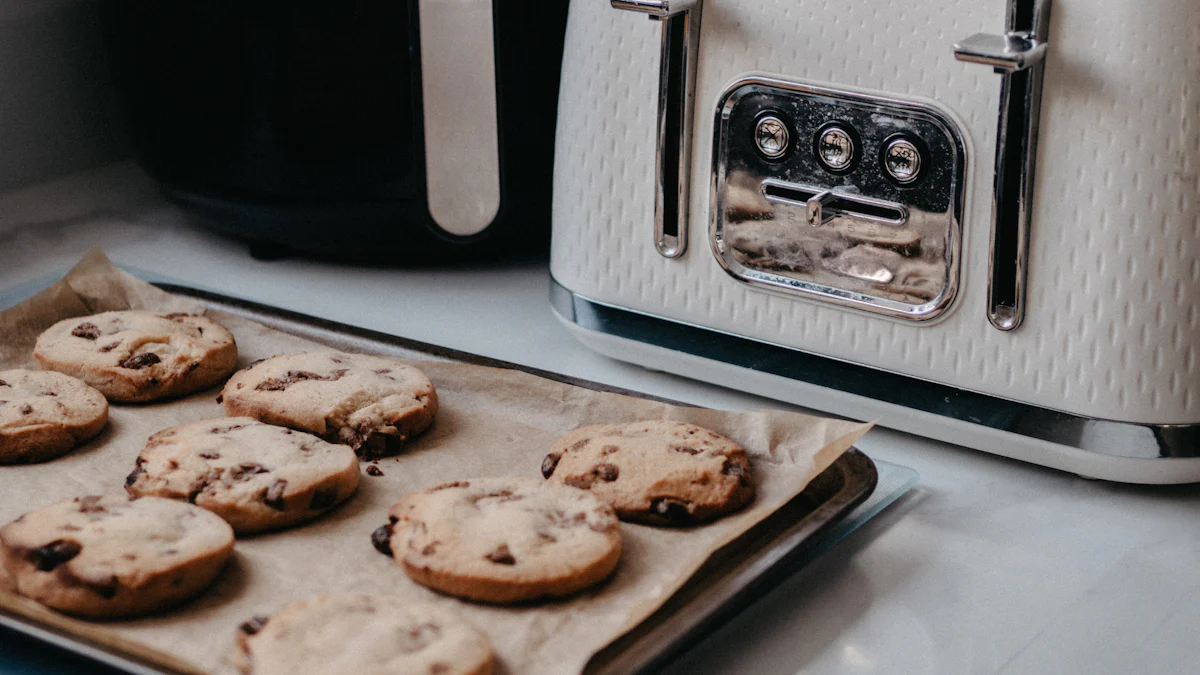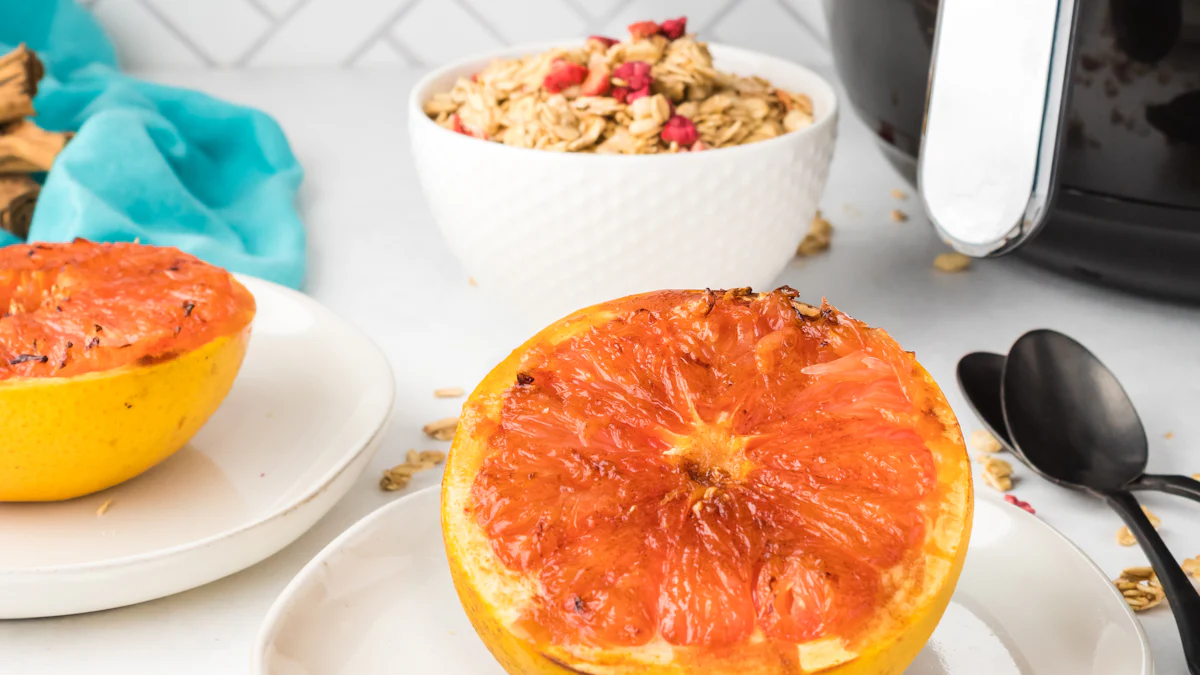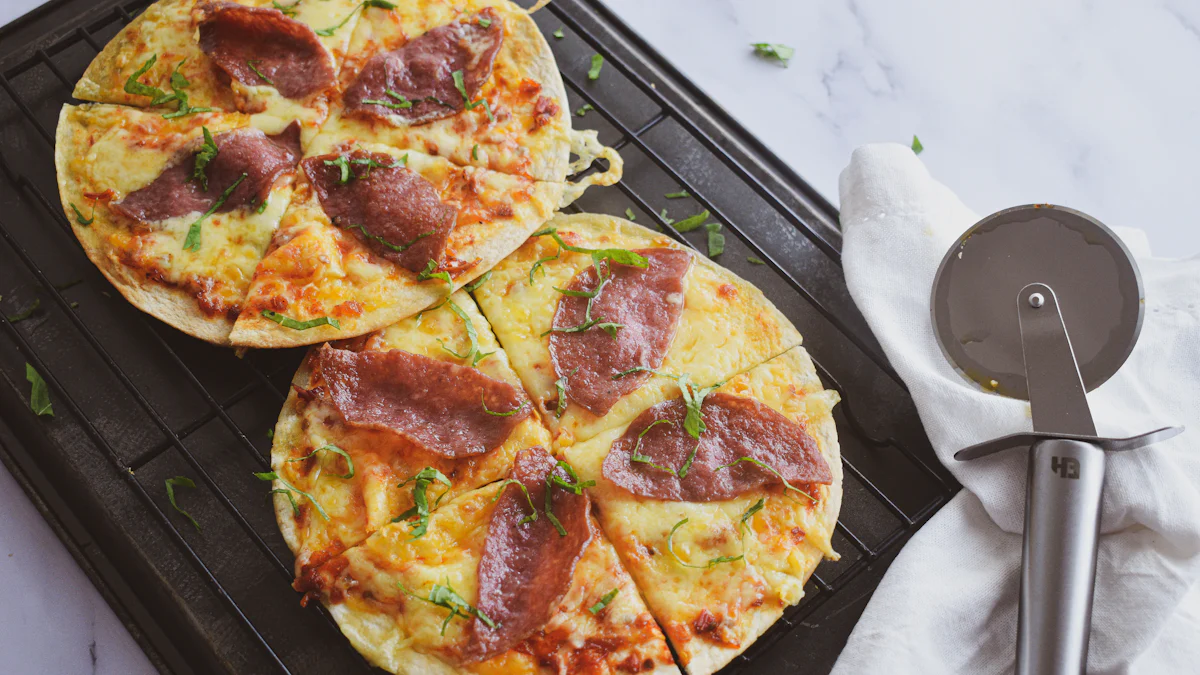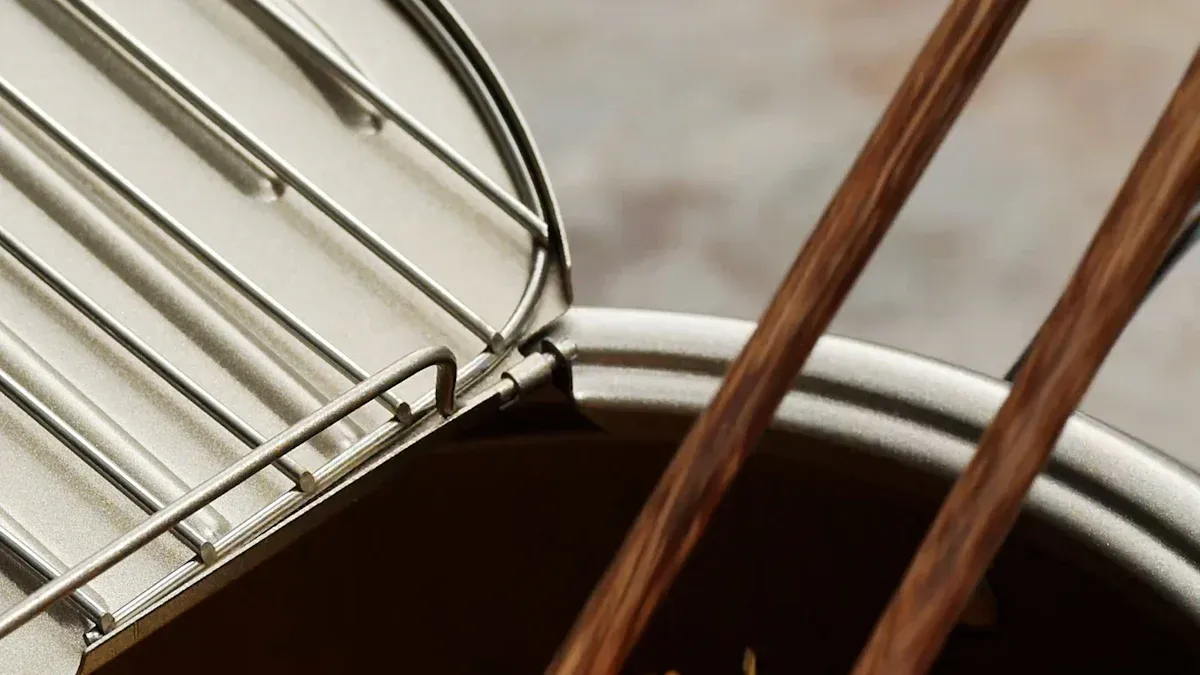
Cooking with an air fryer offers a healthier and faster way to prepare meals. It uses less oil, reducing calorie intake and unhealthy fats. Meals come out crispy without the guilt. Devices like the Electric Multi-Functional Air Fryer and the Electric Deep Fryer Air Fryer make cooking simple and fun, even for beginners. If you’re just starting out, check out some air fryer recipes for beginners and consider investing in an Air Fryer Automatic Large Capacity to expand your cooking possibilities. Start exploring air fryer recipes for beginners today!
What Is an Air Fryer?

An air fryer is a kitchen appliance that has revolutionized the way people cook. It offers a healthier way to enjoy crispy, delicious meals without the need for deep frying. But how does it work, and why is it so popular? Let’s break it down.
How an air fryer works
An air fryer uses hot air to cook food. It has a high-powered fan that circulates this air rapidly around the food placed in a perforated basket or tray. This process cooks the food evenly from all sides. The result? A crispy, golden-brown exterior with a tender and juicy interior. This magic happens thanks to the Maillard Effect, a chemical reaction that gives browned food its unique flavor and aroma. Unlike traditional frying, an air fryer uses only a small amount of oil—or none at all—to achieve that perfect crunch.
Differences between air frying and traditional frying
Air frying and traditional frying may seem similar, but they produce very different results. Here’s how they compare:
- Air frying uses little to no oil, which means meals have lower fat content. This makes it a heart-healthier option.
- Traditional frying submerges food in hot oil, which can lead to higher calorie intake.
- Air fryers reduce acrylamide formation, a potentially harmful compound found in deep-fried foods.
- While traditional frying can leave food greasy, air frying delivers a crisp texture without the mess.
Benefits of using an air fryer
Air fryers offer several advantages that make them a must-have in the kitchen:
- They use less oil, resulting in meals that are lower in fat and calories.
- Cooking with an air fryer is faster and more energy-efficient than using an oven.
- They are versatile, allowing users to fry, bake, roast, and even reheat food.
- Air fryers are safer than deep fryers, as there’s no risk of hot oil splashes.
With these benefits, it’s no wonder air fryers have become a favorite for home cooks everywhere. Whether you’re making fries, chicken wings, or roasted veggies, an air fryer can help you create healthier meals without sacrificing flavor.
Step-by-Step Guide to Using an Air Fryer
Preheating the air fryer
Preheating an air fryer is a simple yet crucial step for achieving consistent results. While not all models require preheating, it’s often recommended for better cooking performance. Here’s how to do it:
- Check the manual for specific preheating instructions for your air fryer model.
- Ensure the basket or tray is clean, dry, and properly inserted.
- If your air fryer has a preheat setting, select it. Otherwise, manually set the temperature to match your recipe.
- Preheat for about three minutes for smaller models or five minutes for larger ones.
- Once preheated, add your food in a single layer to ensure even cooking.
Skipping preheating may add a few extra minutes to your cooking time, but it’s worth the effort for that perfect crispiness.
Preparing food for air frying
Proper preparation makes all the difference. Start by placing the air fryer on a heat-resistant surface. Use parchment paper or aluminum foil to line the basket for easier cleanup. Avoid overcrowding the basket, as this can block airflow and lead to uneven cooking. A light spray of oil can enhance crispiness, but don’t overdo it. For meats, use a thermometer to ensure they’re cooked to a safe temperature. Keeping marinades minimal also helps prevent splattering.
Setting the temperature and timer
Getting the temperature and timer right is key to mastering air fryer cooking. Most recipes provide specific settings, but here’s a quick guide for common foods:
| Food Type | Temperature | Time |
|---|---|---|
| Chicken breasts | 360°F | 20-25 minutes |
| Potatoes (wedges) | 400°F | 20-25 minutes |
| Salmon | 380°F | 12-15 minutes |
| Frozen chicken tenders | 380°F | 15-20 minutes |
Always monitor your food during cooking to avoid overcooking or undercooking.
Flipping and checking food during cooking
Flipping food halfway through cooking ensures even browning. For smaller items like fries or veggies, shaking the basket works well. Periodically checking your food helps you keep track of its progress. If needed, spray a little oil midway to boost crispiness. These small adjustments can make a big difference in the final result.
Cleaning the air fryer after use
Cleaning your air fryer is quick and easy. Follow these steps:
- Unplug the air fryer and let it cool completely.
- Remove the basket and tray, then wash them with warm, soapy water. For stubborn residue, let them soak.
- Wipe the interior and heating element with a damp cloth or sponge.
- Clean the exterior with a damp cloth and mild soap if needed.
- Ensure all parts are dry before reassembling.
Regular cleaning keeps your air fryer in top condition and ensures your meals stay fresh and flavorful.
Essential Tips for Beginners
Using minimal oil for better results
Using less oil is one of the biggest perks of air fryer cooking, but beginners often make mistakes here. A little oil goes a long way in achieving that golden, crispy texture. Here’s a quick guide:
| Food | Amount of Oil |
|---|---|
| French Fries | ½ teaspoon per serving |
| Chicken Wings | None to ¼ teaspoon per serving |
| Vegetables | ½ to 1 teaspoon per serving |
Spray or brush the oil evenly on the food instead of pouring it. This ensures every piece gets crispy without becoming greasy.
Avoiding overcrowding the basket
Overcrowding the basket is a common mistake that leads to uneven cooking. To avoid this:
- Leave space between each piece of food.
- Spread fries or veggies in a single layer for the best crispiness.
- Avoid piling food up, as it blocks airflow and results in soggy textures.
Remember, the air fryer works by circulating hot air. Overcrowding prevents proper circulation, so cook in batches if needed.
Adjusting cooking times for different foods
Different foods require different cooking times. Here’s a handy reference:
| FOOD | TEMPERATURE | AIR-FRYER TIME |
|---|---|---|
| Bacon | 400°F | 5-10 minutes |
| Chicken Breast | 375°F | 22-23 minutes |
| Broccoli | 400°F | 8-10 minutes |
| Fries | 400°F | 10-20 minutes |
| Mini Pizzas | 400°F | 4-5 minutes |
Always check your food halfway through to avoid overcooking.
Optimizing air circulation with proper placement
Proper placement of food in the basket ensures even cooking. Follow these tips:
- Arrange food in a single layer without overlapping.
- Use the perforated basket to allow airflow around each piece.
- Leave enough space for hot air to circulate freely.
This method guarantees crispy results every time.
Troubleshooting common issues
Beginners often face challenges when using an air fryer. Here’s how to solve them:
- Inconsistent Cooking: Shake or flip food halfway through and avoid overcrowding.
- Dryness/Overcooking: Reduce cooking time or temperature and lightly brush oil on food.
- Smoking: Clean the fryer after each use and add water to the drawer when cooking fatty foods.
- Food Sticks to Basket: Rub oil on the basket or use parchment paper.
- Bad Smells: Run the fryer empty at high heat to burn off residues.
With these tips, you’ll master air fryer cooking in no time. Don’t forget to try some air fryer recipes for beginners to build confidence and explore new flavors.
Air Fryer Recipes for Beginners

Simple recipes like fries, chicken wings, and roasted veggies
Starting with simple dishes is the best way to get comfortable with your air fryer. Here are a few beginner-friendly recipes to try:
- Chicken Wings: Preheat the air fryer to 360°F. Toss wings in olive oil and your favorite seasoning. Cook for 25-30 minutes, flipping halfway through for even crispiness.
- Fries: Coat potato slices with a small amount of oil. Cook at 400°F for about 30 minutes, shaking the basket halfway.
- Sweet Potato Fries: Use a sprinkle of smoked paprika or BBQ seasoning for extra flavor. Cook at 400°F for 20-25 minutes.
- Roasted Canned Potatoes: Drain and season canned potatoes. Air fry at 400°F until golden and crispy, about 15 minutes.
These recipes are quick, easy, and perfect for anyone exploring air fryer recipes for beginners.
Foods to avoid in an air fryer
While air fryers are versatile, some foods don’t work well in them. Avoid these items to prevent messes or uneven cooking:
- Wet Batters: They won’t crisp up and can drip, creating a mess.
- Cheesy Items: Melting cheese can burn and stick to the basket.
- Large, Bone-In Meat Cuts: These may not cook evenly.
- Leafy Greens: Lightweight greens like kale can fly around and cook unevenly.
- Rice, Grains, and Pasta: These require water to cook, which air fryers can’t provide.
Stick to foods that can handle the dry heat and airflow of an air fryer for the best results.
Experimenting with frozen and fresh ingredients
Air fryers handle both frozen and fresh ingredients beautifully. To get the best results, follow these tips:
- Preheat the air fryer to 400°F for about 5 minutes.
- Lightly coat fresh vegetables with oil and season them before cooking.
- Avoid overcrowding the basket to ensure even cooking.
- Shake the basket halfway through to promote even browning.
- Adjust cooking times based on the type of food and your desired crispiness.
For frozen foods, no thawing is needed. Just pop them in and adjust the time slightly. Experimenting with both fresh and frozen ingredients will help you discover the versatility of air fryer recipes for beginners.
Cleaning and Maintaining Your Air Fryer
Keeping your air fryer clean ensures it works efficiently and lasts longer. A little maintenance goes a long way in preserving its performance and keeping your meals tasting fresh. Let’s break it down into daily cleaning, deep cleaning, and tips for longevity.
Daily cleaning routine
A quick cleaning routine after each use keeps your air fryer in top shape. Follow these simple steps:
- Unplug and cool: Let the air fryer cool completely before cleaning.
- Wash removable parts: Take out the basket and tray. Wash them with warm, soapy water. If your air fryer is dishwasher-safe, you can use that, but handwashing helps preserve the nonstick coating.
- Wipe down the interior and exterior: Use a damp cloth to clean the inside and outside of the appliance.
- Dry thoroughly: Make sure all parts are completely dry before reassembling.
Tip: Cleaning the removable parts after every use prevents food bits from building up and keeps odors away.
Deep cleaning for stubborn residue
Sometimes, grease and food particles stick to the air fryer. For a deeper clean, try this method:
- Let the air fryer cool and unplug it.
- Remove the basket, tray, and pan. Soak them in hot, soapy water for 10–15 minutes to loosen residue.
- Use a soft-bristle brush or sponge to scrub away any stuck-on food.
- For tough spots, make a paste with baking soda and water. Apply it to the residue, scrub gently, and wipe clean.
- Wipe the heating element with a soft brush to remove grease.
- Clean the interior and exterior with a damp cloth.
- Dry all parts completely before reassembling.
Note: Regular deep cleaning prevents stubborn stains and keeps your air fryer looking and working like new.
Tips to extend the lifespan of your air fryer
Taking care of your air fryer ensures it stays reliable for years. Here are some tips:
- Avoid cooking at maximum temperature for long periods.
- Stick to the recommended temperature range for different foods.
- Clean the air fryer regularly to prevent grease buildup.
- Store it in a cool, dry place to avoid moisture damage.
- Let the air fryer cool between uses to prevent overheating.
- Use oils with a high smoke point to reduce residue.
Reminder: A well-maintained air fryer not only lasts longer but also delivers consistently delicious results.
By following these steps, you’ll keep your air fryer in excellent condition and ready for your next culinary adventure!
Air fryers open up endless possibilities for creating healthier, delicious meals. They reduce oil use, save time, and simplify cleanup, making them perfect for any kitchen. Beginners should explore recipes, try new techniques, and embrace the learning process. With practice, anyone can master this versatile appliance and enjoy its many benefits.
FAQ
How much oil should I use in an air fryer?
A small amount works best. Use ½ to 1 teaspoon for most foods. Spray or brush it evenly for crispy results.
Can I cook frozen food in an air fryer?
Yes! Air fryers handle frozen food well. No thawing needed. Just adjust the cooking time slightly for even crispiness.
Why does my air fryer smoke during cooking?
Smoking happens with fatty foods. Add water to the drawer below the basket to reduce grease splatter and prevent smoke.

